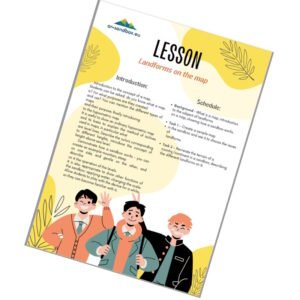The science of water on earth is called hydrology. It examines how water moves and is distributed in the atmosphere, on and under the earth’s surface. Water on land is organized in regions called watersheds – areas of land that drain into a lake, river or other body of water. Watersheds are separated from one another by higher parts of the landscape: ridges, hills, mountains, etc. The Sandbox can be used to visually demonstrate and describe what a watershed is and discuss how human activity impacts watersheds.
Basic Activities
Build various landforms inside the sandpit: hills, valleys and plais. Ask the students to make virtual rain in different parts of the sandbox. Ask questions that will make them think about the movement of water on the earth’s surface.
- What happens to the water when it rains on higher parts of the terrain?
- Where the water stays?
- Where it flows fast and where rather slowly?
Explore the concept of a watershed. You may ask the students if they know what a watershed is. Instruct them to build a long ridge that divides the sandbox into two separate regions. Once they’ve made their predictions, ask a volunteer to make it rain above the ridge. Explain that the water that flows into the first region is part of one watershed, while all the water that flows into the second region is part of a separate watershed. Describe that some watersheds involve very steep terrain while others are part of very subtle topography. In all cases, water always flows to reach the lowest point – an ocean, lake, river, stream, or groundwater source.
It is always a good idea to refer to real-life topography features that will be well known to students. Ask them to model their local watershed (You may want to print a map before the lesson). Challenge them to keep high level of accuracy. Using props like Lego bricks model houses and roads. Let the students observe where the water flows in the watershed. Ask questions like:
- Where does water falling on <a certain location in the sanbox> flow?
- Where do you think the water you are using comes from?
- Are there any sources of pollution along the water’s way and where can they be moved to prevent it?
Discuss water cycle. Ask students what they think happens to the water once it reaches the lowest parts of terrain and bodies of water. You can use the WaterSinking feature to show where groundwater reservoirs can occur. Ask them where they think the rain that they are modeling with their hands comes from. Explain that water is involved in a neverending cycle.
Build a dam (Lego bricks come in handy again). This activity is always fun, yet very informative at the same time. Instruct students how to build a dam: make a large sand wall next to a discrete depression. Make a pass in the sand wall and place bricks there. Fill up the depression with water. Ask students to place buildings around the sand wall, based on their presumption if it’s a floodprone area or not. Once the bricks of the dam are taken away, the water will flood the surrounding terrain. Check the student’s hypotheses and discuss what defines a floodfree terrain. How does that affect the way where and how cities are build? How will the flood water act on heavily built-up surfaces versus ones that have lots of permeable grounds?
Talking flooding, You can ask students to dig a large water basin representing the sea and then see what happens to the coastline when water level rises. Tell students about the importance of careful planning but also our impact on the environment and sea levels. These are important topics and it’s always good to raise awarness amongst the youngest.
Extra Activities
Ask the students to build two contrasting watersheds, divided by a ridge. On one side of the ridge make the watershed simple and structured – one main river bed with regular channels going straight to the lowest floodplains. Let that resemble a man-made landscape. Put some Lego brick houses in the lowest part of the watershed. The other watershed should be more natural looking – with meandering river and some catchment areas in the upper parts representing upland water storage (run-off attenuation features) like rough terrain, trees and leaky dams. Then make the same amount of rain fall on the upper regions of both watersheds. Observe what happens. In the first watershed the water will reach the lowest regions much quicker, while in the second it will flow much slower and some will probably remain in the upper catchments. Ask the students what can be done to decrease the floodrisk in the first watershed. Introduce engineered flood defenses like dams in the main river channel, barriers protecting the houses in the lower regions and maybe some trees planted along the river (these can also be Lego bricks). Repeat the experiment. Tell the students about the importance of flood management and preserving natural environmental features to better control flooding risks.
